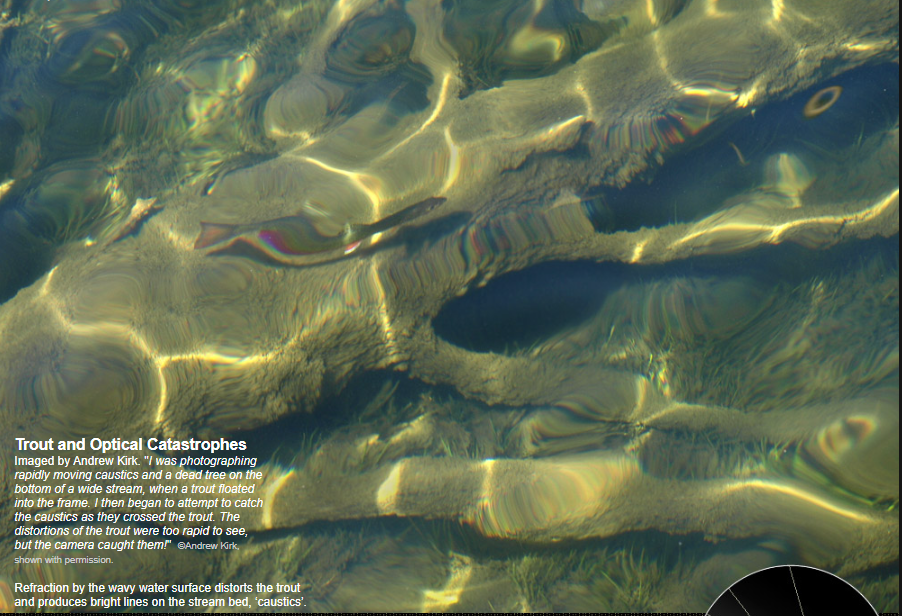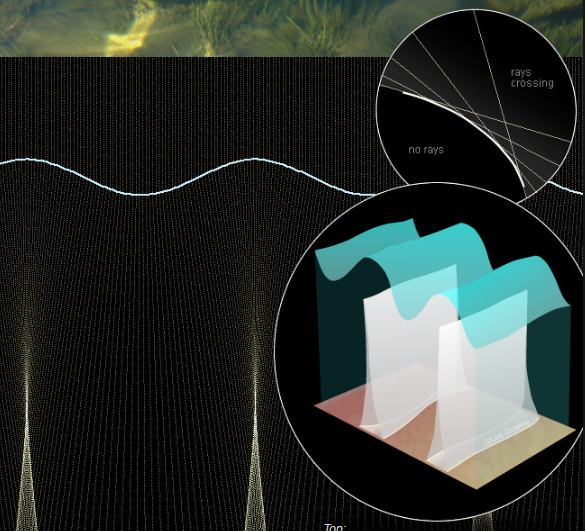OPOD - Trout & Optical Catastrophes
OPOD - Trout & Optical Catastrophes: Exploring the Fascinating World of Caustics
Have you ever gazed into a stream and noticed the mesmerizing patterns of light dancing on the stream bed? These beautiful distortions, known as caustics, are a result of the interaction between light and the wavy surface of the water. Caustics are often attributed to the phenomenon of "focusing" caused by the wavy surface, but there is more to them than meets the eye. In this article, we will delve deeper into the world of caustics and explore their intriguing properties.
Unraveling the Mystery of Caustics
At its core, a caustic is a sheet or line of light that forms within the water. When this sheet intersects with the stream bed or even a passing trout, it creates a wavy line or pattern. But caustics are not just random distortions; they signify sharp spatial discontinuities in the behavior of light rays. This means that the patterns of rays on each side of a caustic sheet are different, adding an element of complexity to their formation.
The Surprising Connection to Catastrophe Theory
To fully understand caustics, we turn to a branch of pure mathematics called catastrophe theory. This intriguing field deals with critical points on a map and their behavior during transitions from one stable point to another. Engineers often apply catastrophe theory to analyze the stability of structures like bridges. Interestingly, this very same mathematics can be used to describe how rays of light behave when they interact with refracting or reflecting surfaces. Caustics, in essence, represent optical catastrophes that occur naturally and possess remarkable stability.
The Stability and Order of Caustics
One might wonder why caustics remain sharp and ordered, unlike the focus achieved through human-made lenses, which can easily blur due to minor perturbations. The answer lies in the stability inherent in caustics. Nature effortlessly generates their sharp and structured forms through the rippling of a stream or the surface of a swimming pool, without any special preconditions. In contrast, creating a telescope lens requires intricate technological processes. Caustics, therefore, exemplify nature's ability to achieve stable focus.
The Seven Elementary Forms of Caustics
A fascinating result stemming from catastrophe theory is that there are only seven stable elementary forms of caustics. These forms include cusp and fold caustics, which exhibit distinct patterns and interactions. The limited variety of caustic forms contributes to their remarkable order and specificity. Although caustics are ever-changing, their shifting patterns remain sharp, familiar, and ordered.
Caustics Beyond Water Surfaces
While we often associate caustics with stream beds and swimming pools, their influence extends far beyond these environments. The arc of a rainbow, the twinkling of stars, the glittering paths on the sea, the curved light patterns in teacups and wine glasses, and even some instances of gravitational lensing are all manifestations of caustics. These diverse phenomena all share a common thread: the presence of caustics and their captivating dance of light.
The Precise Steps of Caustic Dance
Caustics follow precisely prescribed steps, akin to a minuet in light. Their behavior can be accurately described using catastrophe theory, providing insights into their formation and interaction. Whether it's the intricate pairing of caustics with brighter regions between them or the intriguing shapes they assume, caustics continue to captivate scientists and observers alike.
In conclusion, the study of caustics opens up a world of optical wonders. From their formation on water surfaces to their manifestation in various natural phenomena, caustics provide a window into the intricate behavior of light. By exploring the principles of catastrophe theory, we gain a deeper understanding of the stability and order exhibited by these fascinating optical catastrophes. So, the next time you find yourself near a rippling stream or witnessing the beauty of a rainbow, take a moment to appreciate the intricate dance of caustics and the profound science behind their existence.

Trout and Optical Catastrophes Imaged by Andrew Kirk. "I was photographing rapidly moving caustics and a dead tree on the bottom of a wide stream, when a trout floated into the frame. I then began to attempt to catch the caustics as they crossed the trout. The distortions of the trout were too rapid to see, but the camera caught them!" ©Andrew Kirk, shown with permission.
Refraction by the wavy water surface distorts the trout and produces bright lines on the stream bed, ‘caustics’.
Caustics are often ascribed to ‘focusing’ by the wavy surface. Partially true – but why then are they always sharp? A lens focuses rays to a point but change the lens distance and there is only a blur. Why then are caustics not blurred? And why are their dancing patterns strangely structured and persistent rather than random? Why are they so often paired? Why do they apparently like triple junctions or pout into lip shapes? Watch them, there is order there – It transpires that the order is profound.
In its simplest form a caustic is a sheet or line of light within the water and where it intersects a stream bed (or a passing trout) we see a wavy line. It is a region of space where light rays bunch together, coalesce. But it marks something more; the patterns of rays are different on each side of a caustic sheet. Caustics denote sharp spatial discontinuities in ray behaviour.
A comparatively recent branch of pure mathematics, theatrically named ‘catastrophe theory’, has surprising applications to caustics. Catastrophe theory deals with the behaviour of critical points on a map. The name arises because these critical points are ones of stability and transition from one stable point to another can, in the practical world, have dire consequences. For example, engineers apply catastrophe theory to the stability of bridges. One stable point on their map is the desired bridge structure. Twisted girders in the river are another stable point. The discontinuity in behaviour representing bridge collapse is a catastrophe.
The very same mathematics describes how rays from a refracting (or reflecting) surface behave because rays of light from a surface to the eye define a map. Caustics mark discontinuities, optical catastrophes. The theory predicts that they are stable and occur naturally. A rippling stream or swimming pool generates their sharp and ordered forms without special preconditions – they just happen. Compare that to the high-tech effort needed to create a telescope lens. The lens focus is unstable in that any minor perturbation – a change in distance to the focusing screen or an error in figuring – destroys the hard won focus into a blur. Caustics - Nature’s focusing - stay sharp. It is stable – human focusing is not.
A deep result from catastrophe theory is that caustics are not infinite in their variety. There are only seven stable elementary forms. The first two, cusp and fold caustics, are at right. The severe restrictions on form give rise to their remarkable order and to a high specificity in the way they cross and interact. Although ever changing, their shifting patterns remain sharp, familiar and ordered.
Caustics go beyond stream beds and swimming pools. The arc of a rainbow is one. The twinkling of stars, glitter paths on the sea, curves of light in teacups and wine glasses, the sharp spidery shapes seen by spectacle wearers when raindrops get on their lenses and some gravitational lensing are all manifestations of caustics.
Catastrophe theory strictly organises caustics. Their dance is to precisely prescribed steps - a minuet in light.

Top:
Light rays crossing and bunching together form a bright caustic surface (a fold caustic in this example). More profoundly, a caustic marks a topological discontinuity (a catastrophe) in ray behaviour.
Upper right:
Caustic sheets below a wavy surface illuminated by an overhead sun. For each wave crest there are paired sheets (fold caustics) joined at top by a cusp caustic. Where the fold caustics intercept a stream bed they give a bright line.
Background image:
An accurate computation for vertical rays refracted by a wavy water surface. Three rays from the wave crests form the cusps. From elsewhere on the wave, two rays intersect on each point of the downward going fold caustic sheets. Rays from near the wave midpoints where the surface has an inflexion point form the very distant caustics.
The waves were made high amplitude to fit the caustics onto the page. We usually see caustics from gentler surfaces and then the pairing of caustics with brighter regions between them is less obvious.
Note: this article has been automatically converted from the old site and may not appear as intended. You can find the original article here.
Reference Atmospheric Optics
If you use any of the definitions, information, or data presented on Atmospheric Optics, please copy the link or reference below to properly credit us as the reference source. Thank you!
-
<a href="https://atoptics.co.uk/blog/opod-trout-optical-catastrophes/">OPOD - Trout & Optical Catastrophes</a>
-
"OPOD - Trout & Optical Catastrophes". Atmospheric Optics. Accessed on April 20, 2024. https://atoptics.co.uk/blog/opod-trout-optical-catastrophes/.
-
"OPOD - Trout & Optical Catastrophes". Atmospheric Optics, https://atoptics.co.uk/blog/opod-trout-optical-catastrophes/. Accessed 20 April, 2024
-
OPOD - Trout & Optical Catastrophes. Atmospheric Optics. Retrieved from https://atoptics.co.uk/blog/opod-trout-optical-catastrophes/.